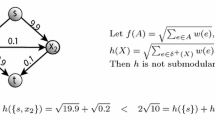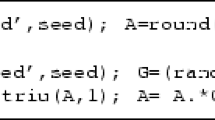Abstract
This paper brings together several topics arising in distinct areas: polyhedral combinatorics, in particular, cut and metric polyhedra; matrix theory and semidefinite programming, in particular, completion problems for positive semidefinite matrices and Euclidean distance matrices; distance geometry and structural topology, in particular, graph realization and rigidity problems.
Cuts and metrics provide the unifying theme. Indeed, cuts can be encoded as positive semidefinite matrices (this fact underlies the approximative algorithm for max-cut of Goemans and Williamson) and both positive semidefinite and Euclidean distance matrices yield points of the cut polytope or cone, after applying the functions 1/π arccos(.) or √. When fixing the dimension in the Euclidean distance matrix completion problem, we find the graph realization problem and the related question of unicity of realization, which leads to the question of graph rigidity.
Our main objective here is to present in a unified setting a number of results and questions concerning matrix completion, graph realization and rigidity problems. These problems contain indeed very interesting questions relevant to mathematical programming and we believe that research in this area could yield to cross-fertilization between the various fields involved.
Similar content being viewed by others
References
F. Alizadeh, Interior point methods in semidefinite programming with applications in combinatorial optimization,SIAM Journal on Optimization 5 (1995) 13–51.
M. Bakonyi and C.R. Johnson, The Euclidian distance matrix completion problem,SIAM Journal on Matrix Analysis and Applications 16 (1995) 646–654.
F. Barahona, On cuts and matchings in planar graphs,Mathematical Programming 60 (1993) 53–68.
F. Barahona and A.R. Mahjoub, On the cut polytope,Mathematical Programming 36 (1986) 157–173.
W.W. Barrett, C.R. Johnson and R. Loewy, The real positive definite completion problem: Cycle completability,Memoirs of the American Mathematical Society 584 (1996) 69 pp.
W. Barrett, C.R. Johnson and P. Tarazaga, The real positive definite completion problem for a simple cycle,Linear Algebra and its Applications 192 (1993) 3–31.
A.I. Barvinok, Problems of distance geometry and convex properties of quadratic maps,Discrete and Computational Geometry 13 (1995) 189–202.
L.M. Blumenthal,Theory and Applications of Distance Geometry (Oxford University Press, Oxford, 1953; Chelsea, New York, 2nd ed., 1970).
E.D. Bolker and B. Roth, When is a bipartite graph a rigid framework?Pacific Journal of Mathematics 90 (1980) 27–44.
J.P.R. Christensen and J. Vesterstrøm, A note on extreme positive definite matrices,Mathematische Annalen 244 (1979) 65–68.
G.M. Crippen and T.F. Havel,Distance Geometry and Molecular Conformation (Research Studies Press, Taunton, Somerset, UK, 1988).
M. Deza and M. Laurent,Geometry of Cuts and Metrics, Algorithms and Combinatorics, Vol. 15 (Springer, Berlin, 1997).
G.A. Dirac, On rigid circuit graphs,Abhandlungen aus dem Mathematischen Seminar der Universität Hamburg 25 (1961) 71–76.
R. Duffin, Topology of series-parallel networks,Journal of Mathematical Analysis and Applications 10 (1965) 303–318.
J. Edmonds, Minimum partition of a matroid into independent subsets,Journal of Research of the National Bureau of Standards B 69 (1965) 67–72.
L. Fejes Tóth, Über eine Punktverteilung auf der Kugel,Acta Mathematica Academiae Scientiarum Hungaricae 10 (1959) 13–19.
H.N. Gabow and H.H. Westermann, Forests, frames and games: Algorithms for matroid sums and applications, in:Proc. 20th Ann. ACM Symp. on the Theory of Computing (1988) 407–421.
M.X. Goemans and D.P. Williamson, 0.878-approximation algorithms for MAX CUT and MAX 2SAT, in:Proc. 26th Ann. ACM Symp. on the Theory of Computing (1994) 422–431.
R. Grone, C.R. Johnson, E.M. Sá and H. Wolkowicz, Positive definite completions of partial hermitian matrices,Linear Algebra and its Applications 58 (1984) 109–124.
R. Grone, S. Pierce and W. Watkins, Extremal correlation matrices,Linear Algebra and its Applications 134 (1990) 63–70.
M. Grötschel, L. Lovász and A. Schrijver, The ellipsoid method and its consequences in combinatorial optimization,Combinatorica 1 (1981) 169–197.
M. Grötschel, L. Lovász and A. Schrijver,Geometric Algorithms and Combinatorial Optimization, Algorithms and Combinatorics, Vol. 2 (Springer, Berlin, 1988).
B. Hendrickson, The molecule problem: Determining conformation from pairwise distances, Ph.D. Thesis, Tech. Rept. 90–1159, Dept. of Computer Science, Cornell University, Ithaca, NY, 1990.
B. Hendrickson, Conditions for unique graph realizations,SIAM Journal on Computing 21 (1992) 65–84.
B. Hendrickson, The molecule problem: Exploiting structure in global optimization,SIAM Journal on Optimization 5 (1995) 835–857.
C.R. Johnson, Matrix completion problems: a survey, in: C.R. Johnson, ed.,Matrix Theory and Applications, Proceedings of Symposia in Applied Mathematics, Vol. 40 (American Mathematical Society, Providence, RI, 1990) 171–198.
C.R. Johnson, C. Jones and B. Kroschel, The distance matrix completion problem: Cycle completability,Linear and Multilinear Algebra 39 (1995) 195–207.
C.R. Johnson, B. Kroschel and H. Wolkowicz, An interior-point method for approximate positive semidefinite completions, CORR Rept. 95-11, University of Waterloo, 1995, to appear inComputational Optimization and Applications.
C.R. Johnson and T.A. McKee, Structural conditions for cycle completable graphs,Discrete Mathematics 159 (1996) 155–160.
R.M. Karp, Reducibility among combinatorial problems, in: R.E. Miller and J.W. Thatcher, eds.,Complexity of Computer Computations (Plenum Press, New York, 1972) 85–103.
G. Laman, On graphs and rigidity of plane skeletal structures,Journal of Engineering Mathematics 4 (1970) 331–340.
M. Laurent, The real positive semidefinite completion problem for series-parallel graphs,Linear Algebra and its Applications 252 (1997) 347–366.
M. Laurent, A connection between positive semidefinite and Euclidean distance matrix completion problems,Linear Algebra and its Applications (1997), to appear.
M. Laurent, A tour d’horizon on positive semidefinite and Euclidean distance matrix completion problems, in: P. Pardalos and H. Wolkowicz, eds.,Topics in Semidefinite and Interior-Point Methods, The Fields Institute for Research in Mathematical Science, Communications Series, Providence, RI (1997), to appear.
M. Laurent, Max-cut problem, in: M. Dell’Amico, F. Maffioli and S. Martello, eds.,Annotated Bibliographies in Combinatorial Optimization (John Wiley & Sons, New York, 1997), to appear.
M. Laurent and S. Poljak, On a positive semidefinite relaxation of the cut polytope,Linear Algebra and its Applications 223–224 (1995) 439–461.
J. de Leeuw and W. Heiser, Theory of multidimensional scaling, in: P.R. Krishnaiah and L.N. Kanal, eds,Handbook of Statistics, Vol. 2 (North-Holland, Amsterdam, 1982) 285–316.
Chi-Kwong Li and Bit-Shun Tam, A note on extreme correlation matrices,SIAM Journal on Matrix Analysis and its Appplications 15 (1994) 903–908.
R. Loewy, Extreme points of a convex subset of the cone of positive semidefinite matrices,Mathematische Annalen 253 (1980) 227–232.
L. Lovász and Y. Yemini, On generic rigidity in the plane,SIAM Journal on Algebraic and Discrete Methods 3 (1982) 91–98.
Y.E. Nesterov and A.S. Nemirovsky,Interior Point Polynomial Algorithms in Convex Programming: Theory and Algorithms (SIAM Publications, Philadelphia, PA. 1994).
P.M. Pardalos and X. Lin, A tabu based pattern search method for the distance geometry problem, in: F. Giannessis et al., eds.,Mathematical Programming (Kluwer Academic Publishers, Dordrecht, 1997).
S. Poljak and Z. Tuza, Maximum cuts and largest bipartite subgraphs, in: W. Cook, L. Lovász and P.D. Seymour, eds.,Combinatorial Optimization, DIMACS Series in Discrete Mathematics and Theoretical Computer Science, Vol. 20 (AMS, Providence, RI, 1995) 181–244.
M.V. Ramana, An exact duality theory for semidefinite programming and its complexity implications,Mathematical Programming 77 (1997) 129–162.
B. Roth, Rigid and flexible frameworks,The American Mathematical Monthly 88 (1981) 6–21.
D.J. Rose, R.E. Tarjan and G.S. Lueker, Algorithmic aspects of vertex elimination on graphs,SIAM Journal on Computing 5 (1976) 266–283.
J.B. Saxe, Embeddability of weighted graphs ink-space is strongly NP-hard, in:Proc. 17th Allerton Conf. in Communications, Control and Computing (1979) 480–489.
I.J. Schoenberg, Remarks to M. Fréchet’s article “Sur la définition axiomatique d’une classe d’espaces vectoriels distanciés applicables vectoriellement sur l’espace de Hilbert”,Annals of Mathematics 36 (1935) 724–732.
I.J. Schoenberg, Metric spaces and positive definite functions,Transactions of the American Mathematical Society 44 (1938) 522–536.
R.E. Tarjan, Decomposition by clique separators,Discrete mathematics 55 (1985) 221–232.
J.A. Wald and C.J. Colbourn, Steiner trees, partial 2-trees and minimum IFI networks,Networks 13 (1983) 159–167.
W. Whiteley, Matroids and rigid structures, in: N. White, ed.,Matroid Applications, Encyclopedia of Mathematics and its Applications, Vol. 40 (Cambridge University Press, Cambridge, MA, 1992) 1–53.
K. Wüthrich, Protein structure determination in solution by nuclear magnetic resonance spectroscopy,Science 243 (1989) 45–50.
Y. Yemini, Some theoretical aspects of position-location problems, in:Proc. 20th Ann. Symp. on Foundations of Computer Science (1979) 1–8.
Author information
Authors and Affiliations
Rights and permissions
About this article
Cite this article
Laurent, M. Cuts, matrix completions and graph rigidity. Mathematical Programming 79, 255–283 (1997). https://doi.org/10.1007/BF02614320
Received:
Accepted:
Issue Date:
DOI: https://doi.org/10.1007/BF02614320




